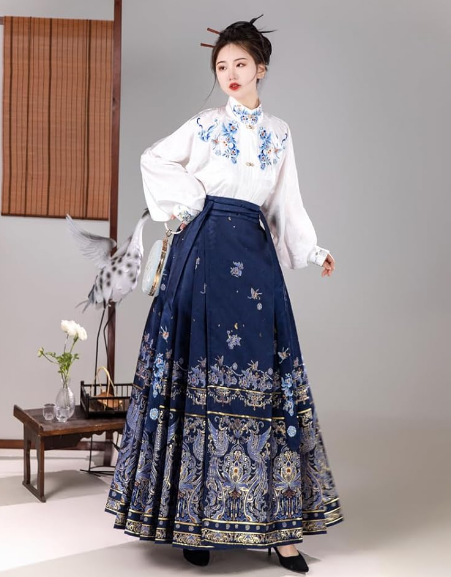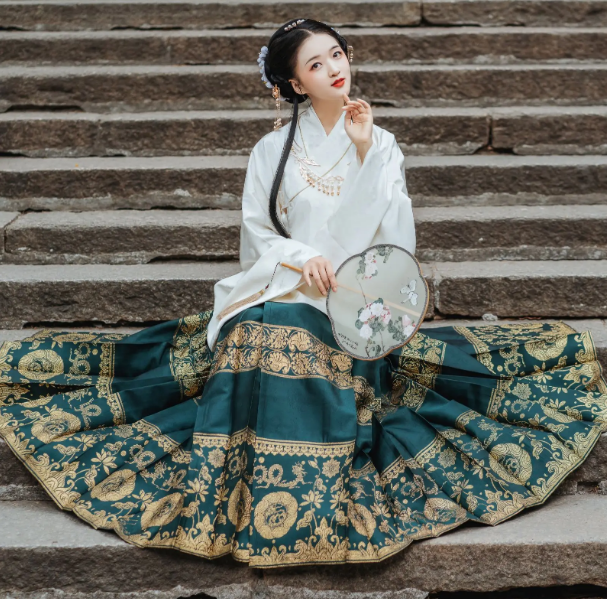Historical Origins of the Horse-Face Skirt
The Evolution of the Skirt’s Design
Originating from East Asia, the horse-face skirt took inspiration from traditional attire. Designers created this skirt with pleats or panels, echoing a horse’s majestic profile. It gained fame for combining traditional grace with practical freedom of movement.
As fashion tastes evolved, so did the skirt’s width and panel count. It adapted to new textile techniques, transitioning from basic fabrics to luxurious silk.
Cultural Significance in Historical Context
The skirt often marked social status and regional identity. Its material and pattern could signify a wearer’s social standing. For instance, during the vibrant Tang dynasty, art and literature celebrated this skirt style, cementing its societal importance.

Used in ceremonies and festivals, the skirt showcased craftsmanship and cultural pride. Though lacking exact historical data on costs, silk horse-face skirts were likely pricey. The production speed varied with the design’s complexity and the craftsperson’s skill. Despite this, the horse-face skirt’s detailed creation process undoubtedly increased its cultural and monetary value.
The horse-face skirt thus stands as a testament to the artistic and social fabric of its time.
The Design Features of a Horse-Face Skirt
Unique Construction and Paneling
A horse-face skirt distinguishes itself with its structured pleating. Artisans craft each panel to flare out, much like the visage of a horse, which grants the skirt its name. This construction provides volume and movement, allowing the wearer a blend of elegance and mobility. The number of panels can vary, with some skirts featuring upwards of ten or more, each precisely stitched to maintain the desired shape.
These panels are not only decorative but functional, giving the skirt a flexibility that supports a wide range of activities. Whether made from traditional cotton or luxurious silk, the material quality directly influences the skirt’s flow and durability.
Comparison to Other Skirt Styles
When placed side by side with, for example, a pencil skirt or an A-line skirt, the horse-face skirt stands out due to its volume and dynamic silhouette. Unlike the pencil skirt that confines movement, the horse-face skirt allows for a graceful stride. The A-line skirt shares some similarities in comfort but lacks the distinctive paneling that sets the horse-face design apart.
In terms of cost, a horse-face skirt generally requires more material and labor, which can raise its price point compared to simpler styles. The time taken to produce one skirt hinges on the intricacy of its design—more panels mean more hours of labor. Skirts with complex embroidery or high-quality fabrics can take skilled artisans several days to complete.
The horse-face skirt, with its unique panels and historical significance, thus holds a distinct place in the spectrum of skirt designs. It reflects a commitment to both form and function that has been cherished throughout its history.
Symbolism and Naming Conventions
Interpretation of the “Horse-Face” Moniker
The name “horse-face skirt” comes from its distinctive paneling, reminiscent of a horse’s wide and long face. This moniker serves more than just a literal resemblance; it symbolizes strength and grace, qualities admired in both the animal and the wearer. The horse, as a symbol, has been associated with power, nobility, and freedom across various cultures, which the skirt’s flowing panels aim to capture.
In fashion, naming conventions often reflect the garment’s visual impact or the emotion it evokes. The “horse-face” label thus immediately conveys an image of the skirt’s design and suggests its movement and fluidity.
Symbolic Representations in Fashion
Fashion often uses symbolism to communicate identity and values. The horse-face skirt, in its form, can represent a connection to historical roots and cultural identity. For instance, when someone wears a horse-face skirt during a traditional festival, it can serve as a homage to ancestors and a celebration of heritage.
Moreover, designers may choose specific materials or colors for the horse-face skirt to convey different meanings. Silk, for example, often denotes luxury and status, while cotton could signify simplicity and practicality. The cost of a silk horse-face skirt can be significant, reflecting its value as a status symbol. It could take over 20 hours to complete a single skirt, depending on the complexity of its design, which adds to its exclusivity and worth.
In this way, the horse-face skirt carries both a visual appeal and a deeper significance within its folds, making it a garment rich with cultural symbolism.
Regional Variations and Influences
Geographic Differences in Style
The horse-face skirt varies from region to region, adapting to local fashion sensibilities and needs. For example, in colder climates, the skirts may be longer and made of heavier fabrics to provide warmth. In contrast, tropical regions favor lighter materials like cotton or linen for ventilation and ease of movement.
Each region also brings its own palette of colors and textures to the design, often inspired by the local environment. These regional styles not only offer practical benefits but also serve as a map of cultural exchange, where the horse-face skirt adapts and evolves through influence and innovation.
Influence of Ethnic and Cultural Dress
Ethnic and cultural dresses deeply influence the horse-face skirt’s design elements. Embroidery patterns, color choices, and fabric types often draw from traditional costumes, infusing the skirt with cultural narratives and ethnic identity. For instance, the use of indigo dye or batik patterns can trace back to specific communities and their historical textile practices.
In regions with a strong tradition of weaving and textile production, the horse-face skirt often showcases the pinnacle of local craftsmanship. The time taken to weave and dye fabrics by hand can significantly add to the skirt’s value, making each piece a unique work of art. The cost of these artisanal skirts can reflect the hours of labor—sometimes over a hundred hours for a single skirt—invested in their creation, alongside the cultural significance they carry.
These regional and cultural influences ensure that the horse-face skirt is not just a fashion item but a bearer of stories and traditions, constantly being reinterpreted through the lens of contemporary fashion.
Horse-Face Skirt in Modern Fashion
Revival and Contemporary Interpretations
Designers often look to the past for inspiration, bringing classic styles like the horse-face skirt into modern wardrobes. They reinterpret this traditional piece with new materials, like sustainable fabrics, to align with contemporary values around environmental responsibility. A modern twist to the horse-face skirt could include digital prints or unconventional textures, making each piece a statement in innovation.

The revived skirts may maintain the original silhouette but often play with length and volume to suit modern tastes. A horse-face skirt might be redesigned as high-waisted or combined with modern cuts to appeal to today’s fashion-forward consumers.
The Skirt’s Place in Today’s Fashion Industry
In today’s fashion industry, the horse face skirt represents a blend of nostalgia and avant-garde. It finds its place in both high fashion and streetwear, as its adaptable design suits a variety of occasions and styles. The cost of a designer horse face skirt can be quite high, depending on the brand and the quality of the materials used.
Fashion shows and cultural festivals often feature the horse face skirt, celebrating its cultural roots while showcasing its evolution. These skirts may command high prices, with luxury versions costing hundreds or even thousands, while more affordable versions make the style accessible to a broader audience.
This skirt has become a canvas for designers to express both respect for tradition and a push for modernity, proving that historical garments can have a significant impact on current trends.
Social and Cultural Impact
The Skirt’s Role in Social Identity and Expression
The horse face skirt often serves as a medium for personal expression and social identity. In certain communities, it might signal marital status or age, with specific patterns or colors reserved for single or married women, or different age groups. For many, wearing this skirt can be a proud display of cultural heritage, showcasing their connection to tradition and community values.
In urban settings, individuals might wear the horse face skirt as a fashion statement, expressing their unique style and breaking from conventional clothing norms. The versatility of the skirt allows it to move beyond its traditional boundaries, becoming a symbol of individuality and self-expression in the modern world.
Media and Popular Culture References
The horse face skirt often appears in films, television shows, and literature as a representation of cultural identity, especially in stories focusing on historical or regional narratives. Its depiction in media can lead to a resurgence in popularity, as new audiences discover the garment’s beauty and significance.
Celebrities and influencers might don the horse face skirt at public events, sparking discussions and interest in its history and design. The media coverage can greatly influence the public’s perception, often leading to increased demand and, subsequently, to a higher market value for the skirt. When a popular figure wears a horse face skirt, it can quickly become a sought-after item, with prices varying greatly depending on the designer and the intricacy of the skirt’s pattern and material.
Through media and popular culture, the transcends its traditional role, becoming a dynamic part of global fashion dialogue and social commentary.